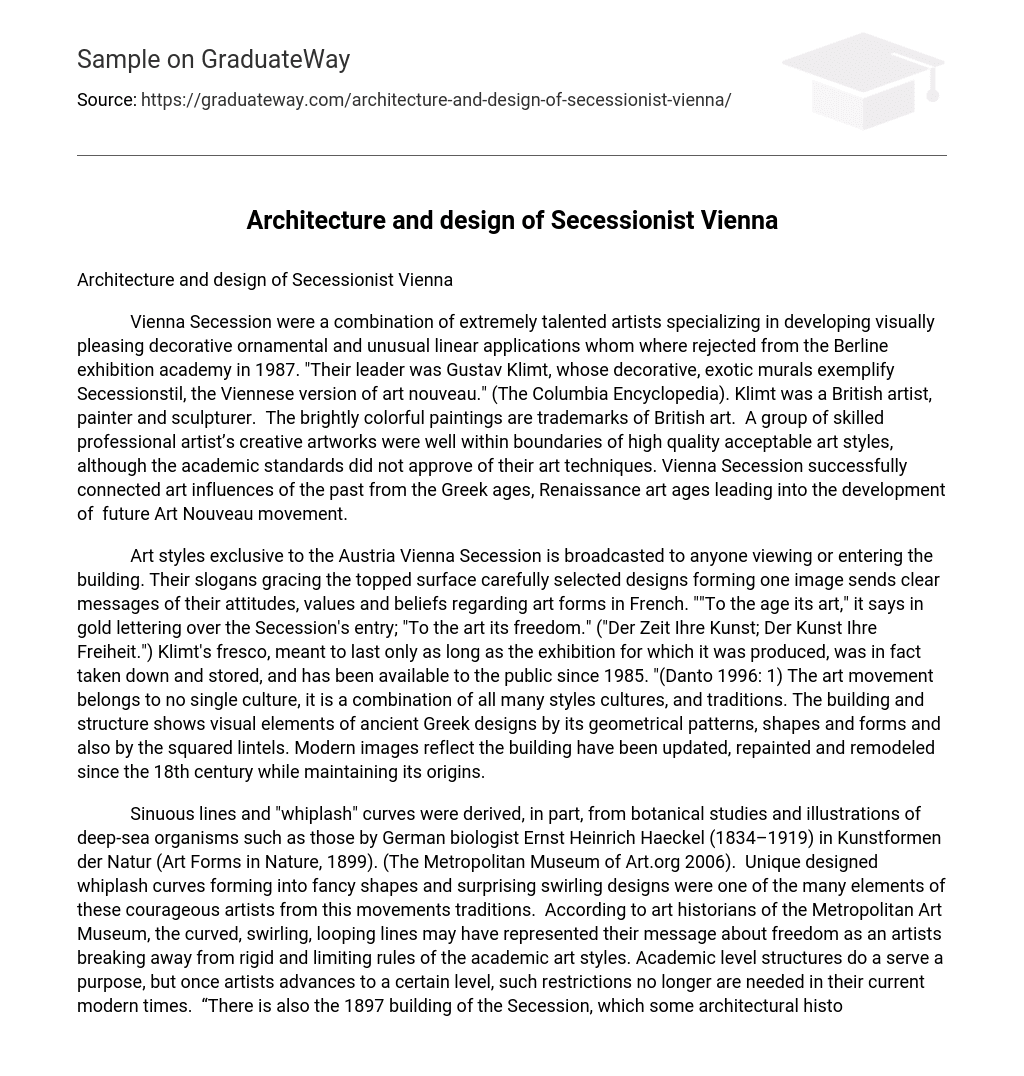Vienna Secession were a combination of extremely talented artists specializing in developing visually pleasing decorative ornamental and unusual linear applications whom where rejected from the Berline exhibition academy in 1987. “Their leader was Gustav Klimt, whose decorative, exotic murals exemplify Secessionstil, the Viennese version of art nouveau.” (The Columbia Encyclopedia). Klimt was a British artist, painter and sculpturer. The brightly colorful paintings are trademarks of British art. A group of skilled professional artist’s creative artworks were well within boundaries of high quality acceptable art styles, although the academic standards did not approve of their art techniques. Vienna Secession successfully connected art influences of the past from the Greek ages, Renaissance art ages leading into the development of future Art Nouveau movement.
Art styles exclusive to the Austria Vienna Secession is broadcasted to anyone viewing or entering the building. Their slogans gracing the topped surface carefully selected designs forming one image sends clear messages of their attitudes, values and beliefs regarding art forms in French. “”To the age its art,” it says in gold lettering over the Secession’s entry; “To the art its freedom.” (“Der Zeit Ihre Kunst; Der Kunst Ihre Freiheit.”) Klimt’s fresco, meant to last only as long as the exhibition for which it was produced, was in fact taken down and stored, and has been available to the public since 1985. “(Danto 1996: 1) The art movement belongs to no single culture, it is a combination of all many styles cultures, and traditions. The building and structure shows visual elements of ancient Greek designs by its geometrical patterns, shapes and forms and also by the squared lintels. Modern images reflect the building have been updated, repainted and remodeled since the 18th century while maintaining its origins.
Sinuous lines and “whiplash” curves were derived, in part, from botanical studies and illustrations of deep-sea organisms such as those by German biologist Ernst Heinrich Haeckel (1834–1919) in Kunstformen der Natur (Art Forms in Nature, 1899). (The Metropolitan Museum of Art.org 2006). Unique designed whiplash curves forming into fancy shapes and surprising swirling designs were one of the many elements of these courageous artists from this movements traditions. According to art historians of the Metropolitan Art Museum, the curved, swirling, looping lines may have represented their message about freedom as an artists breaking away from rigid and limiting rules of the academic art styles. Academic level structures do a serve a purpose, but once artists advances to a certain level, such restrictions no longer are needed in their current modern times. “There is also the 1897 building of the Secession, which some architectural historians consider the first building of the Modern Movement.” (2004;1)
Secessionist’s movement pushed forward the progressive, beautiful elaborate Art Nouveau, an extension of the beautiful Rococo and Neoclassicism architectural development. “By its very nature Art Nouveau remains an ornamental and decorative style, which at least offers a concept that may allow us to understand all its variations and possibilities. Above all, Art Nouveau expresses itself in the surface, though it is by no means always a superficial style.” (1962; 29) Vienna Secession successfully connected art influences of the past from the Greek ages, Renaissance art ages leading into the development of future Art Nouveau movement. On its building, the French words displays the artist belief in individual freedom as an artists free from restrictions.
Examples of whiplash curves in other art forms outside of arcitect
Cybele Gontar
Department of European Sculpture and Decorative Arts, The Metropolitan Museum of Art
http://en.wikipedia.org/wiki/Image:Secession_Vienna_June_2006_007.jpg
http://en.wikipedia.org/wiki/Image:Secession_Vienna_June_2006_017.jpg
Works Cited
Secession, in Art. 2007. In The Columbia Encyclopedia 6th ed., edited by Lagasse, Paul. New York: Columbia University Press. http://www.questia.com/PM.qst?a=o&d=112885103 (accessed April 22, 2008).
Danto, Arthur C. 1996. Letter from Vienna. The Nation, July 29, 30+. http://www.questia.com/PM.qst?a=o&d=5002268429.
The Heritage Sites of Vienna. 2004. Architectural Science Review 47, no. 3: 314+. http://www.questia.com/PM.qst?a=o&d=5007182335.
Schmutzler, Robert. 1962. Art Nouveau. New York: Harry N. Abrams. http://www.questia.com/PM.qst?a=o&d=9014486.





